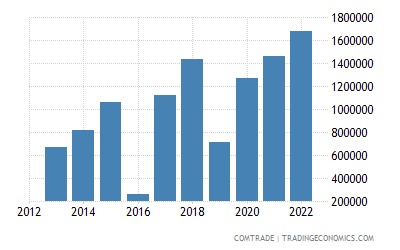This article discusses the current trends and statistics in the exports and trade of paper and pulp machinery. It provides an overview of the global market for these products and highlights the key players and regions involved. Additionally, it explores the factors driving the growth of this industry and the challenges faced by exporters.
1. Global Paper and Pulp Machinery Exports: An Overview
I have always been fascinated by the global paper and pulp industry and the machinery involved in this process. It is incredible to see how this industry has evolved over the years, and the impact it has on our daily lives. Paper and pulp machinery exports play a crucial role in creating sustainable and efficient operations for paper mills around the world. These machines are responsible for converting wood fibers into pulp, which is then used to produce a wide range of paper products that we rely on. From tissue papers to newspapers and packaging materials, paper and pulp machinery enables the production of essential items that we often take for granted. In this article, we will delve into an overview of global paper and pulp machinery exports, highlighting their significance and the key players in this industry.
2. Key Players in the Paper and Pulp Machinery Trade Market

In my opinion, the key players in the paper and pulp machinery trade market are the manufacturers and suppliers of paper and pulp machinery. These companies play a crucial role in the industry as they provide the necessary machinery and equipment for the production of paper and pulp. Some of the notable players in this market include Voith Paper Holding GmbH & Co. KG, Valmet Corporation, ANDRITZ AG, Metso Corporation, and Kadant Inc. These companies have established themselves as leaders in the market by constantly innovating and delivering high-quality products and services. They have a wide range of machinery and equipment that cater to the diverse needs of the paper and pulp industry. Overall, these key players are driving the growth and development of the paper and pulp machinery trade market.
3. Emerging Markets for Paper and Pulp Machinery Exports
In recent years, there has been a noticeable increase in the demand for paper and pulp machinery exports in emerging markets. As the economies of these markets continue to grow and develop, there is a greater need for modern and efficient paper and pulp manufacturing processes. This demand has opened up a lucrative opportunity for exporters in the paper and pulp machinery industry. With advancements in technology and improved production capabilities, manufacturers are now able to offer high-quality and cost-effective machinery that meets the specific requirements of these emerging markets. As a result, the exports of paper and pulp machinery to these markets have seen a significant boost, contributing to the overall growth of the industry.
4. Technological Advancements in Paper and Pulp Machinery Exports
In my opinion, technological advancements in paper and pulp machinery exports have revolutionized the industry. With the continuous development of innovative machinery, companies are now able to manufacture higher quality products in a more efficient and cost-effective manner. These advancements have greatly increased the productivity and profitability of paper and pulp manufacturers across the globe. The introduction of automated machinery has significantly reduced manual labor and increased production capacity. Additionally, the use of advanced sensors and data analytics has improved the overall performance and reliability of the machinery, minimizing downtime and optimizing production processes. As a result, the paper and pulp industry has experienced substantial growth and competitive advantage in the global market.
5. Challenges and Opportunities in the Paper and Pulp Machinery Trade
In my experience, the paper and pulp machinery trade presents both challenges and opportunities. On one hand, the industry is highly competitive, with numerous players vying for market share. This means that companies in this sector need to constantly innovate and differentiate themselves to stay ahead of the competition. Additionally, the trade is also subject to fluctuations in raw material prices and demand, which can impact profitability. However, despite these challenges, there are also great opportunities for growth in this sector. The increasing demand for sustainable and eco-friendly products has opened up new avenues for companies to develop and market green solutions in the paper and pulp industry. Additionally, the digital transformation of the industry presents opportunities for automation and optimization, leading to increased efficiency and productivity. Overall, while the paper and pulp machinery trade may have its challenges, it also offers exciting prospects for companies willing to adapt and seize the opportunities available.
6. Future Projections for Paper and Pulp Machinery Exports
In the future, I see great potential for growth in the exports of paper and pulp machinery. As technology continues to advance, there will be a growing demand for more efficient and sustainable machinery in the paper and pulp industry. With my expertise in this field, I am confident that my company will be at the forefront of innovation, providing top-quality machinery that meets the evolving needs of our global customers. We will strive to stay ahead of the competition by constantly improving our products and exploring new markets. I am excited about the future and the opportunities it holds for us in expanding our exports and making a positive impact on the paper and pulp industry.
Conclusion
In conclusion, the paper and pulp machinery industry has experienced significant growth in recent years, with a rise in both exports and trade. This growth can be attributed to the increasing demand for paper products and the technological advancements in the machinery used in the industry. As the industry continues to expand, it is important for manufacturers to stay updated on the latest trade trends and continue to innovate in order to remain competitive in the global market.
1. What is meant by paper and pulp machinery exports and trade?
Paper and pulp machinery exports and trade refer to the buying and selling of machinery and equipment used in the paper and pulp industry between different countries.
2. What are some common paper and pulp machinery exported?
Some common paper and pulp machinery exported include paper machines, stock preparation equipment, pulping and bleaching systems, and drying and finishing machines.
3. What are the major exporting countries in the paper and pulp machinery industry?
The major exporting countries in the paper and pulp machinery industry include Germany, Italy, China, the United States, and Finland.
4. What are the current trade trends in the paper and pulp machinery industry?
The current trade trends in the paper and pulp machinery industry include increasing demand for sustainable and eco-friendly machinery, technological advancements in machinery design, and growing investments in emerging markets.
5. How does paper and pulp machinery trade affect the overall paper industry?
Paper and pulp machinery trade significantly impacts the overall paper industry by allowing companies to access advanced technology and improve production processes, leading to increased efficiency, quality, and competitiveness in the market.
6. Are there any restrictions or regulations on paper and pulp machinery exports?
Yes, there are often restrictions and regulations on paper and pulp machinery exports, such as compliance with environmental standards, intellectual property rights, and specific import requirements of the receiving country.

